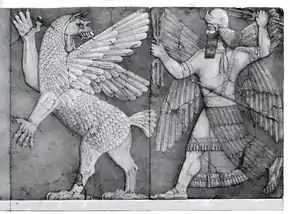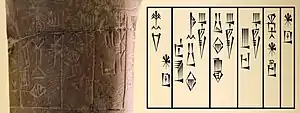Nammu
In Sumerian mythology, Nammu (also Namma, spelled ideographically 𒀭𒇉 dNAMMA = dENGUR) was a primeval goddess, corresponding to Tiamat in Babylonian mythology.
| Part of a series on |
| Ancient Mesopotamian religion |
|---|
 Chaos Monster and Sun God |
| Related topics |
Nammu was the Goddess sea (Engur) that gave birth to An (sky father) and Ki (earth mother) and the first gods, representing the Apsu, the fresh water ocean that the Sumerians believed lay beneath the earth, the source of life-giving water and fertility in a country with almost no rainfall.
Nammu is not well attested in Sumerian mythology. She may have been of greater importance prehistorically, before Enki took over most of her functions. An indication of her continued relevance may be found in the theophoric name of Ur-Nammu, the founder of the Third Dynasty of Ur. According to the Neo-Sumerian mythological text Enki and Ninmah, Enki is the son of An and his mother, Nammu. Nammu is the goddess who "has given birth to the great gods". It is she who has the idea of creating mankind, and she goes to wake up Enki, who is asleep in the Apsu, so that he may set the process going.[1]
The Atrahasis-Epos has it that Enlil requested from Nammu the creation of humans, and Nammu told him that with the help of Enki (her son) she can create humans in the image of gods.
Reay Tannahill in Sex in History (1980) singled out Nammu as the "only female prime mover" in the cosmogonic myths of antiquity. [2]
A votive inscription to Namma, by Lugal-kisalsi, King of Uruk circa 2380 BCE:
𒀭𒇉 / 𒁮𒀭𒊏 / 𒈗𒆦𒋛 / 𒈗𒀕𒆠𒂵 / 𒈗𒋀𒀊𒆠𒈠 / 𒂍𒀭𒇉 / 𒈬𒆕
{d}namma / dam an-ra / lugal-kisal-si / lugal unu{ki}-ga / lugal urim5{ki}-ma / e2 {d}namma / mu-du3"For Namma, the wife of An, Lugalkisalsi, king of Uruk and king of Ur, the temple of Namma he built."
References
- Gwendolyn Leick, A dictionary of ancient Near Eastern mythology, Routledge, 1991, ISBN 978-0-415-00762-7, p. 124.
- Tannahill, Reay (1980). Sex in history. Stein and Day/Publishers/New York. p. 51. ISBN 0-8128-2580-2.
- Art of the First Cities: The Third Millennium B.C. from the Mediterranean to the Indus. Metropolitan Museum of Art. 2003. pp. 64–65. ISBN 978-1-58839-043-1.
- "Inscription of Lugal-kisalsi".

_-_EnKi_(Sumerian).jpg.webp)